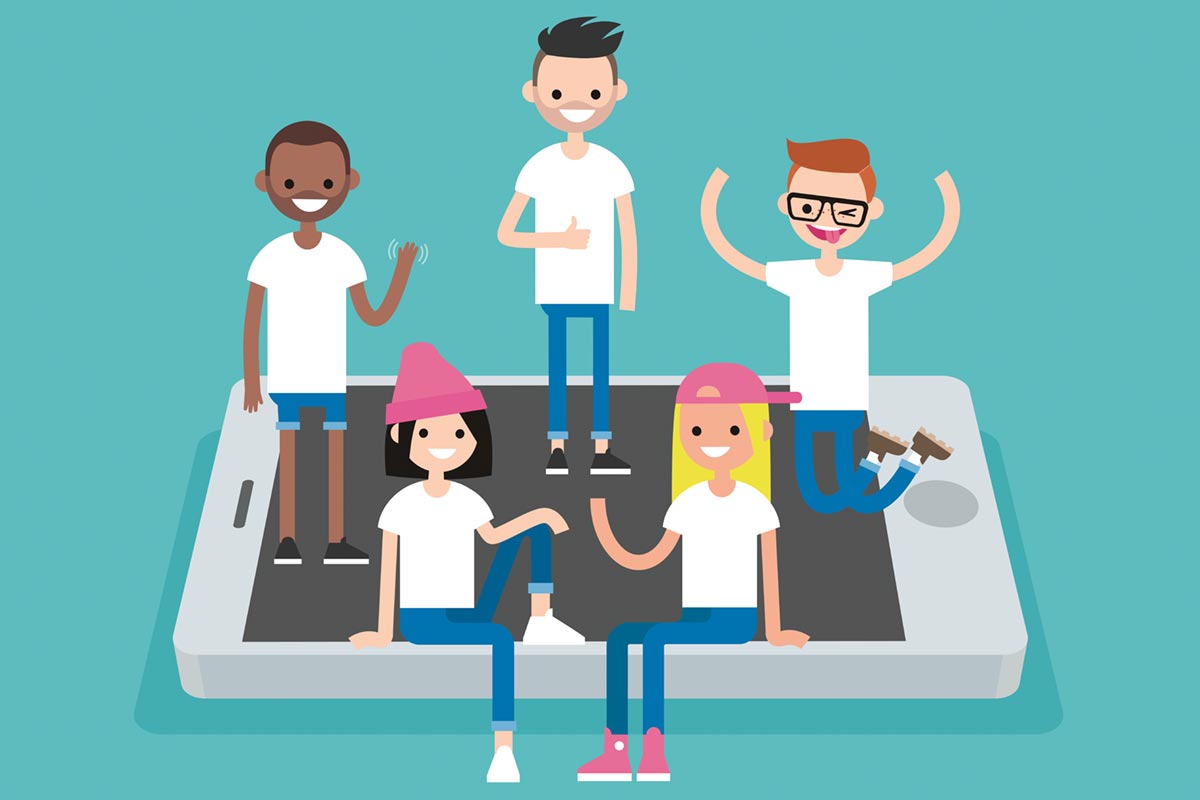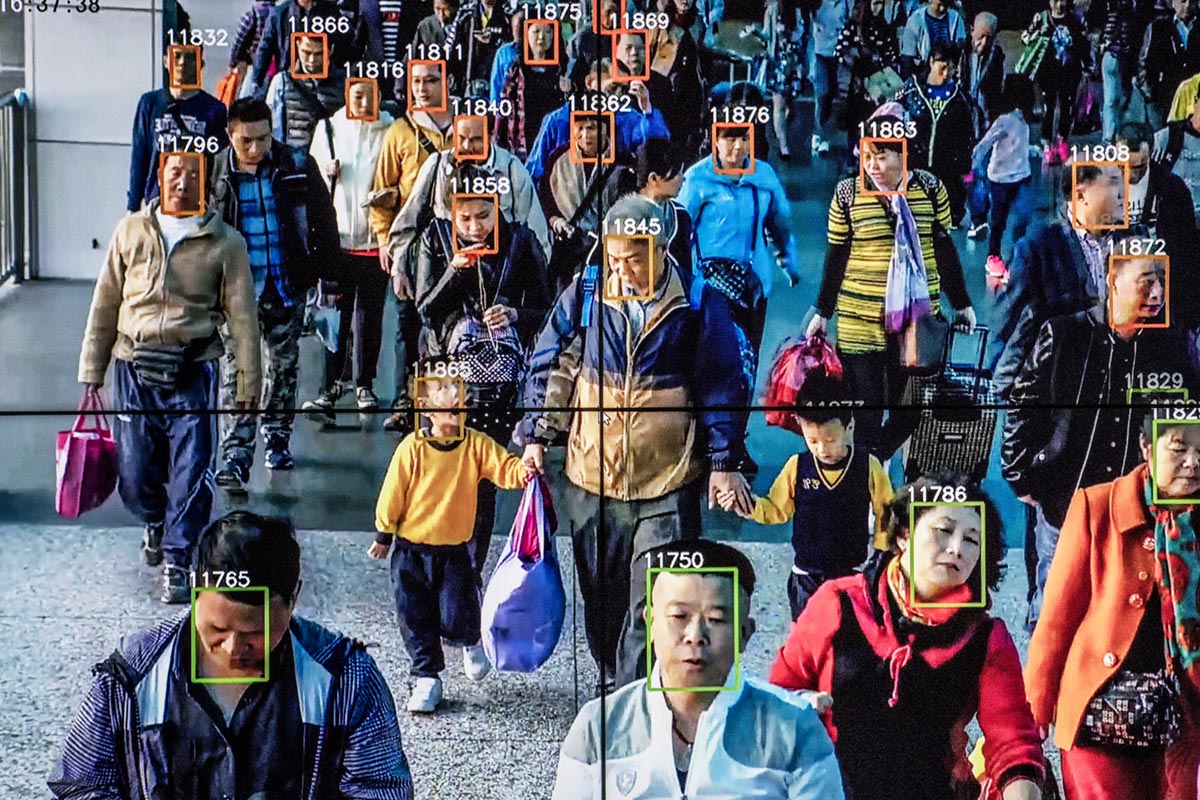Trends in Brief

Trends in Brief
“Why is it not working?” seems to be one of the most asked questions in every meeting room. Many companies claim that they will deliver a “one-click” solution, but some are thinking even further. Earlier this year, Microsoft showed off a 360 degree camera and microphone, specifically designed for meetings.
Meeting rooms of the future
“Why is it not working?” seems to be one of the most asked questions in every meeting room. Many companies claim that they will deliver a “one-click” solution, but some are thinking even further. Earlier this year, Microsoft showed off a 360 degree camera and microphone, specifically designed for meetings. The camera can detect anyone in the room and throughout the meeting, and the microphone transcribes everything they say, regardless of language. Microsoft has also added AI that listens in on the meeting and reacts to certain words and phrases, sending out notifications to participants who, for example, promised to book a meeting. Amazon’s Alexa has a similar setup, and can also check that all the tech is working beforehand.
The legalities of the gig economy
With companies like Uber, TaskRabbit and Postmates, the gig economy got a new face. Workers are encouraged to join the services and work whenever they want, wherever they want, which might sound good to many. However, in reality, the “no full-time contracts” business model has been criticized for hurting workers’ rights. When Uber pays way less for their drivers, it makes it impossible for competitors to keep up without lowering their own drivers’ salaries or adopting the same business models. Supporters call it a revolution and point out how cheap a taxi ride has become with Uber, but the opposing side has already managed to have Uber’s original business model banned in a long line of cities, including London.
How to make your hires smarter
Removing names and pictures from CVs was just the first step. In an effort to remove biases in hiring, big tech companies have found new ways to filter out talent. The startup GapJumpers, which collaborates with Google, has created a software program that facilitates blind auditions solely focused on an applicant’s skills (like on The Voice). The company has found that this increases the number of female applicants and employees, which is something Google has had a big problem with before.
Another startup in this field is Textio, which helps companies write job descriptions with less gender-associated words. There are also job sites that think outside the box, like recruitment marketplace Search Party, which only shows employers anonymous profiles with just enough information to make an informed hiring decision.
Ellen Montén
Move over, millennials – gen Z is here

Move over, millennials – gen Z is here
In 2015, millennials overtook both baby boomers and Generation X, becoming the largest share of the US workforce. But who is the new generation after the millennials and what can we expect from it?
Generation Z is typically defined as those born between 1995 and 2009, and we are already discovering that as businesses we may need to alter our approach to recruit, lead and market to this new generation. Generation Zers outnumber their millennial predecessors and they will likely not have just one career, but instead alternate between different careers, transiently. Money is often not the main object but instead the human and social connection, where they get to work with an empire of young people doing cool stuff. For Generation Z, it’s Snapchat, Instagram and Whisper rather than Facebook, Twitter and selfies that characterized millennials. “We absorb information instantaneously and lose interest just as fast”, reports a soon to be graduate. She is very concerned about her brand and more importantly her privacy having seen her older sibling be overly generous in how much he “posts on Facebook”. This is why she prefers Snapchat where images disappear as fast as they arrive.
Children of a post 9/11 world
So, what are the major differences between the millennials and Generation Z? Generation Z’s outlook is shaped differently, they have grown up in a post 9/11 world and in an era of economic volatility. Single sex marriage is now legal. The UK is on its second female prime minister and the US has had its first African American president and all of this is taken for granted. Without overgeneralizing they seem to be more conscientious, hardworking and mindful of the future world. They were raised by Generation Xers, who also experienced times of equal volatility and who value safety more highly. A Sparks and Honey trend report asserts that, as a cohort, this new generation appears more “mature and in control”. What do businesses need to be aware of in their approach to recruiting Generation Zers that may be subtlety different compared to previous years? “Subtle” is the key word here, as many of the elements below are not necessarily at odds with what we know of our millennials.
- Even more technology driven. Our Generation Zers have different expectations of a workplace, fully enabled by technology.
- Even more global. All businesses have the capacity to be global with virtual teams that create new levels of workforce flexibility. Despite Brexit and the US presidential election having us believe in the rise of nationalism, our Generation Zers will value diversity and inclusion as vital elements for growing businesses and societies.
- Entrepreneurial. This generation is “multi-potential” and therefore contributing to our growing gig economy – which may pose problems for corporate culture creation as we look to distinguish our businesses from others in the growing war for talent.
- Prudence and pragmatism. Growing up in global recessions with increased student debt, this generation is aware of the need to develop relevant skills that businesses will value in the workplace and in return they expect structure, professional development, mentorship and career advancement – and fast!
- Communication. Over 50 percent of our Generation Zers value face to face communication over other forms. This is in sharp contrast to the millennials so perhaps as employers we will see an increased capability in this area.
- Disruption. In a world where hackers are respected, they see the word “disruptive” as a more positive characteristic that should be encouraged.
- Less focused and split-tasking. Shorter attention spans will likely disrupt current workflows. How work is allocated and completed in a multi device environment will need to be considered by businesses when designing future roles and defining business processes.
“Less self centered and entitled, and instead collaborative, accountable and eager to learn.”
I am constantly impressed at how graduates seek to make a difference and assume ownership of ambitious projects. They are less self centered and entitled, and instead collaborative, accountable and eager to learn and contribute to the business agenda. Although some future aspects may be sharper in relation to Generation Z, there are many traits that they share with their predecessors. They both assimilate information and networks much quicker than previous generations, they care deeply about ethical leadership in relation to the environment and society.
Changing the voice of sports

Changing the voice of sports
In the fall of the year 2000 Aftonbladet revolutionized Swedish sports journalism, as the paper became the first in the country to publish a daily sports supplement. The recipe for success? How about pink paper, fake assignments, and social media?
The year 2000. What do we remember about it? Bill Clinton was the President of the United States of America, Playstation 2 was introduced and Britney Spears was on top of the singles list. Some things feel like yesterday, others like an eternity ago. Today it is hard to imagine what the media landscape and media habits looked like just after the turn of the millennium. When internet was something fairly new, social media did not even exist and smartphones could only be seen in sci-fi films. There was no place to watch television – except on the TV in the living room. All Swedes interested in sports surely have some sweet memories of the Olympic games in Sydney where Sweden won four gold medals; Swedish successes that were reported in the first sports daily, Sportbladet. Already back in the 90s there had been plans for an extended sports coverage at Aftonbladet, but the sports editor at the time, Lasse Östling, can still remember the frustration he felt as he was walking to work to fill a few sports pages.
A historic swedish victory
“I remember with horror when I went to the editorial office one evening after Sweden had beaten England at Råsunda Football Stadium in an important qualification fixture. Fredrik Ljungberg had just had his breakthrough, this was a historic Swedish victory and I had only six pages in total to work with, and all the other stuff was supposed to fit in there as well; horse trotting, ice hockey training matches and much more, whatever it was. I remember asking the editorial management how I was supposed to produce decent coverage of a victory that was the talk of the nation?
After some years, in the early 1990s, with poor attendance at sports events, Swedish audience numbers had begun to increase again. The appearance of commercial sports TV channels sparked a new interest. This was the time when the idea of starting a new daily Swedish sports paper was born. “There was a happy, party-like mood on the Swedish stands” Östling says. “The old men in the top management began to understand that we should have a product that was matching those interests and not just something that was dismissed to some silly pages far back in the evening paper.” In 1996 Aftonbladet had overtaken its fiercest rival Expressen in circulation figures. At its widest the gap was almost 100,000 copies a day, but in the late 1990s Expressen had begun to lose in and the editorial management felt that something had to be done. The decision was to put increased effort into covering sports. Fearing that the competitors might get wind of the new plan everything had to be done in secret.
“Instead of a couple of sport pages a day there was now going to be at least 16 pages.”
Aftonbladet started hiring new, young sports journalists but to avoid any unneccesary attention they were not assigned to the sports desk – Sportbladet did not yet exist – but to other desks at the paper. Some of the sports columnists-to-be were put to work for a month with the Sunday edition and not even those who worked at the sports desk at the time knew that they were going to move to Sportbladet.
The pink paper was a signal
Another move, which was made just a couple of months before the launch, was to start printing on pink paper resembling the respected Italian sports paper La Gazzetta dello Sport.
The pink color was a signal saying that the paper was going to take readers interested in sports seriously. Instead of a couple of sport pages a day there was now going to be at least 16 pages every day in a separate supplement. On May 8, 2000 Sportbladet was launched but the reception was cool among people in the trade. Many asked themselves how Aftonbladet was going to fill 16 sports pages (later to become 32) every day of the year. But fairly soon it turned out that the large space opened up for another type of sports journalism and a different kind of journalist. Over night there was suddenly room enough to tell stories rather than just report results and events on the pitch. Now the coverage was about the football culture in Moscow or what football in Bucharest meant for the Roma population of Romania.
“Sportbladet proved some things that few people had dared hope or think”, says the Sportbladet columnist Simon Bank, who has been with the paper since 1999. “First, that Sweden was large enough to have a daily sports paper. Second, that Sweden on top of that had enough curiosity to appreciate journalism and reporting, that is not only about the closest, most audience-catching topics. And be read and admired for it”, Bank says.
Thanks to this, not only was a new audience coming to the sports pages, but also a new brand of journalists. “Erik Niva and Johanna Frändén had perhaps been possible 30 years ago but they would not have been writing in the same style, about the same topics. Now they are among the best writers there are in Sweden, regardless of category”, Bank says. 18 years after the launch the pink sports pages are still there, just as the basic values of quality, curiosity and courage. But more and more energy is used for the digital traffic and there are plenty of challenges.
“It has been a fantastic journey and it’s still going on”, says the present editor of Sportbladet Pontus Carlgren. “We develop and change all the time. Today we are not only producing a daily paper. We are working with social media, videos, podcasts and an IT development that can be absolutely decisive. The tone of presentation that was typical for Sportbladet still exists but can now also be heard clearly in all our social media. In our new organization we have three staff members working with social media. All three of them have a background as subeditors at the paper, and that is not a coincidence”, Pontus Carlgren says.
A pioneering spirit
Several of the profiles at Sportbladet have been awarded prizes for their journalism and much of the playfulness and pioneering spirit that distinguished Sportbladet 18 years ago still lives on, both in the editorial room and in the marketing department. In the spring of 2018 4,373 footballs were dumped all over Sergels Torg in the center of Stockholm as a reminder of the long, warm – and pink – World Cup summer that lay ahead.
Wanted: 1,000 bags with plastic junk

Wanted: 1,000 bags with plastic junk
More than 15 tons of plastic is dumped into our oceans every minute. Today there is a quarter of a kilo of plastic in the ocean for every five kilos of fish. This is why Finn.no started the campaign Havplast – ocean plastic – and by that, took another stand for the environment.
It all started with a stranded whale, outside Bergen in Norway in early 2017. When it was cut open researchers found that it was filled with plastic and the problem with ocean litter became obvious to the whole of Norway. The public learned that if we continue like this, there will be as much plastic as fish in the ocean in 33 years, according to researchers. “We believe that brands can be activists and we want to engage our consumers in responsible consumption – and help life below water. Norway is one of the countries in the world with the longest coastline. The problem is real for most Norwegians and it’s crucial that we act”, explains Hanne Lill Johnsen, Marketing Manager. The idea that came up was also within their core; to create a classified category for ocean plastic on Finn.no. Then they posted an ad: “We want to buy 1,000 bags with marine litter for 10 USD a bag”. Everyone that answered the ad received a bag and was asked to fill it with marine litter and post a new ad on Finn.no, who would then buy it. The 1,000 bags were gone in hours. So, Finn bought 5,000 more. They were gone in days. They then invited other brands into the project. One bank bought 2,500 bags. Ikea set up containers where people could deposit their bags. In the summer of 2017, thousands of Norwegians took to the beaches to help clean up the coastline.
100 school classes helped out
In 2018 Finn wanted to do something new. “We teamed up with a kids environmental club, Miljøagentene, and reached out to 5th graders to help us collect plastic from the beaches”, says Hanne.
5,000 kids did an impressive job, collecting and learning about the plastic problem. More than 100 school classes contributed. They all got 20 bags each which Finn bought. All together plastic worth 30,000 USD was sold.
For Finn the ocean plastic project is much more than a single campaign. Being a marketplace for secondhand trade, the environment and the climate issue is directly connected to their business. “Our core is about reuse – and that is part of the solution for our climate. And a part of a more circular economy.” And just as people want to help collect ocean litter, more and more people also want to contribute to a more sustainable world. And this is what all the users at Finn.no and other marketplaces are doing when buying and selling used stuff.
Secondhand sales save on plastic
To make this more visible, Finn is also part of a Schibsted project called The Second Hand Effect, where they measure the environmental benefit from secondhand trade. The idea is to investigate how much material and emissions can be saved through secondhand trade, if each secondhand product replaces the production of a new one. Then this is recalculated into greenhouse gases. In 2017 ten of Schibsted’s marketplaces, all over the world, participated in the project. When adding up the result, it turns out that the users on these sites saved 21.5 million tons of greenhouse gases. And to connect the dots – they also avoided 1.2 million tons of plastic to be produced – when instead buying and selling used things. “The Second Hand Effect shows us that small actions can make a big difference for the planet”, says Communication Officer Kristine Eia Kirkholm.
A new space age

A new space age
After decades in the shade space is back on the agenda. Private entrepreneurs are pushing the limits of exploration, speaking about living on Mars and exporting our dirty work. And we tend to listen – filled with hope, existential fears and imagination.
June 27th 2018, northern Sweden. We gathered outside on the porch to watch the “blood moon of the century”. The whole family was there for the event, with cheese, snacks, wine and candy for the kids. As a bonus we got to see the Red Planet rise above the treetops. It was a rare occasion. The gathering of the family, that is. What is the thing with space? Why does it capture our imagination and emotion so much? After a relatively quiet phase in the public eye, one thing is for sure: space is back on the public agenda! In force. Let us look back together on space technology, space politics, space music and spacemen.
My first truly emotional encounter with space was a good 25 years earlier. Our infantry unit was practicing night operations when the sky suddenly lit up green. Wow, the major brought green flares instead of red! Not quite. At the edge of space, at the Kármán line 100 kilometers above our astonished faces, the magnetosphere shielded us from the electromagnetic onslaught from outer space. The Northern Lights interrupted our battle plans, and the major, in an uncharacteristic turn of events, called off practice and took the squad for a hike up the nearest hill to get a better view of the show. It was the freakiest of shows.
Ground Control to Major Tom
Take your protein pills
And put your helmet on
Ground Control to Major Tom
Commencing countdown
Engines on
Check ignition
And may God’s love be with you
– Space Oddity, David Bowie, 1967
Don’t be afraid of the man in the moon, sang David Bowie on his self titled debut album, two years before Neil Armstrong took one giant leap for mankind in 1967. The pop icon extraordinaire was never far from space and launched his next album and Major Tom into pop history only a month ahead of Apollo 11. Music was for the longest time one of the few ways we could approach the unfathomable space, and Space Oddity was a spectacular record.
Music and space intersected on another spectacular disc: the Voyager Golden Record. This gold plated copper record with a catalogue of human culture, biology and ambition was sent into deep space on Voyager 1 in 1977. Complete with a map of who we are, our DNA and a map to our home, The Mix Tape of the Gods, floats through nothingness as humanity’s invitation card. A shout into the void, desperately beckoning: is anybody out there?
We humans have been looking to the stars for millennia, at least, with this existential question. One of the earliest recordings of space travel and extraterrestrials is “True History” by Lucian of Samosata in the 2nd century AD. In the novel he visited the moon and found a people at war with the people of the Sun. Italian astronomer Giovanni Schiaparelli observed “canali’ on Mars in 1877 which led to instant speculation. In 1896 Nicolas Tesla suggested that we could contact the people of Mars using his wireless electrical transmission system, and actually thought he had detected a signal at one point. Our fascination with space has always been there, and has evolved over time.
Early space exploration in the 1950s and 1960s was more practical than emotional and focused on the challenge. John F. Kennedy’s speech in 1962 articulated the moon as a beckoning frontier and a pioneering challenge, ripe for capture by a nation with pioneering in its blood. The global competition with the Soviet Union was ever present.
But why, some say, the moon?
Why choose this as our goal?
And they may well ask, why climb the highest mountain?
Why, 35 years ago, fly the Atlantic?
We choose to go to the moon!
We choose to go to the moon in this decade and do the other things, not because they are easy, but because they are hard.
– John F. Kennedy, 1962
The moon is not a destination, it is a direction, continued Apollo 11 astronaut Mike Collins. In 1989 George Bush Sr. said the ultimate goal was not simply to go there and go back, but to go there and go on. Well, we have not gone back. Perhaps Collins and Bush would be disappointed that no man has set foot on the moon for over 40 years? It makes sense to me. We have been there, done that. Why go back? There is no actual utility of going to the moon, is there?
While NASA no longer sends astronauts to the International Space Station, it’s private entrepreneurs who are pushing the limits of space exploration, and making us look to the sky again. They articulate their motivation for the hard, risky, and in most ways unrewarding enterprise quite differently. Elon Musk, SpaceX founder and CEO, claims that space exploration is a necessity for the survival of mankind. When (not if) World War III breaks out our best bet to save humanity is to ensure “there’s enough of a seed of human civilization to bring human civilization back”. That seed should be planted on Mars. The other Space Baron billionaire, Jeff Bezos, sees space as a place to do our dirty work – mining, manufacturing, and recycling – in order to preserve Earth as a cleaner and nicer place to live. Bezos foresees space stations with millions of workers.
Yet, the most inspiring sales pitch for space is not these rational arguments. It is Elon Musk’s knack for quirky PR. Letting Jonathan “Jonah” Nolan, co-creator of Westworld, edit a short video where SpaceX’s newest rocket, the Falcon Heavy, launches a Tesla roadster into space to the tunes of David Bowie’s Life on Mars, is nothing short of communication genius. We get to see cheering crowds of people gathered around Kennedy Space Center, children with binoculars, a dummy astronaut named Starman, and a Voyageresque message etched into the circuitry: “Made on Earth by Humans”. As to the why of this movie Elon Musk tweeted:
Why Falcon Heavy & Starman? Life cannot just be about solving one sad problem after another. There need [sic] to be things that inspire you, that make you glad to wake up in the morning and be part of humanity. That is why we did it. We did [it] for you. – Elon Musk on Twitter, 2018
So, space is our hope and our existential fear. A muse for the greatest pop icons. Space is also our challenge and frontier, worthy of our finest engineers. It is certainly back on the agenda, in part thanks to bold entrepreneurs with spectacular vision and intelligent machines. What more? It is without doubt politics. Not everyone is pleased with space exploration and the undertones of going to Mars to save the human race. The Apollo program had its own share of critics. The main point was that spending billions of tax dollars on rockets was a sad priority when there were more pressing needs here on Earth – inequality, poverty, hunger, war. Gil Scott-Heron quipped in the introduction to Whitey on the moon: “I wanna give credit where credit is due”.
Was all that money I made last year
For whitey on the moon?
How come I ain’t got no money here?
Hmm! Whitey’s on the moon
Y’know I just ‘bout had my fill
Of whitey on the moon
I think I’ll send these doctor bills
Airmail special
To whitey on the moon
– Whitey on the Moon, Gil Scott-Heron, 1970
The present day launch of Falcon Heavy, and the accompanying live stream watched by millions, earned opprobrium in new ways. To some, the privatization of space exploration signals billionaire escapism in a very tangible way, while the poor masses are left on a boiling Earth. Although it might be a bit unfair to demand of engineers Bezos and Musk to solve Earth politics when politicians cannot.
The Cold War space race is over, and clearly winning space ahead of the Russians is perhaps not as motivating. Still, the United States of America is getting a Space Force, according to president Donald Trump! The idea of a Space Force, despite it sounding like the prologue of a sci-fi film, has been floating around since the late 90s. I suspect the reason to bring it to the forefront now is that it still captures the minds of voters, telling a story of power, strength and technical advancements.
One thing is for sure. Space is not good business. Financially speaking it is nothing short of a black hole. The US space programs have cost some 500 billion dollars of present day tax money. Critics say private space projects only seem to surface when men, who had space on their mind as boys, come into significant money. Or government. Musk and Bezos have already been mentioned. But did you know Paul Allen of Microsoft also has a space company; Stratolaunch Systems Corp? Richard Branson is chairing his Virgin Galactic. Bezos, currently the richest man on Earth, says he divests a billion USD of his Amazon stock every year to fund his space venture Blue Origin. As we ride the fumes of the longest bull market in history, there is certainly an element of newly created private riches looking for increasingly long shot investments. And what is farther out than space? Supporters admire the fact that these private fortunes are diverted into something useful for mankind. I guess it depends on how you define useful, in contrast to for example the Bill and Melinda Gates Foundation.
To the man on the street space is first and foremost entertainment. Few things capture our imagination as the Star Wars saga, and the story permeates back into reality. For example, in October 2007, NASA launched a space shuttle carrying an original lightsaber from the Star Wars set into orbit. You already know the SpaceX line of rockets are named Falcon. There is also the Yoda purpurata, a species of acorn worm. Ronald Reagan’s Strategic Defense Initiative, a shield of lasers and missiles to intercept incoming missiles, was quickly labeled “Star Wars”. In England and Wales almost 400,000 people stated their religion as Jedi on their 2001 census forms, surpassing Judaism and Buddhism. In Brighton, England 2.6 percent claimed to be Jedi.
There have been several crucial technological advancements lately. Tales of mechanical men, golden robots and clockwork automatons turning from fiction into science, through the pioneering work of Alan Turing in the 1950s to today’s deep learning algorithms. You see, an essential part of deep space exploration is robotics. Sadly, we humans cannot keep up with our own imagination and ambition in the flesh, despite the Final Countdown. To build Martian bases, mine asteroids and explore lightyears of deep space, intelligent machines are a necessity. Oxygen-sucking, carbohydrate-eating mensch just don’t cut it. We need robots that perform complex tasks autonomously, and even replicate themselves. Today, as artificial intelligence is increasingly becoming a reality and less of science fiction, even the most audacious of plans seem achievable. This is perhaps the clearest driver of the return of space to the agenda. The simple fact that we can do it.
We are programmed just to do
Anything you want us to
We are the robots, We are the robots
We are the robots, We are the robots
We’re functioning automatic
And we are dancing mechanic
– We are the Robots, Kraftwerk, 1978
And the fact that new technologies inspire new achievements was clear to another musician, creating a mega hit. Rock band Europe’s The Final Countdown almost never made it out of Joey Tempest’s teenage drawer. He was experimenting on the synthesizer Korg Polysix when he found the famous riff. “Some people think that tech and music are unrelated. But new tech feeds new ideas”, he claimed in an interview. Much later when the song, to the band’s surprise, became an instant hit, Joey commented: “It is so simple, borderline banal, very close to the line.”
Close to the Kármán line perhaps? New tech feeds new ideas. And new ideas feed new tech. That’s not rocket science. What remains to be seen is if we are all leaving together. Or if most of us stay grounded until the next blood moon of the century.
We’re leaving together,
But still it’s farewell
And maybe we’ll come back
To Earth, who can tell?
I guess there is no one to blame
We’re leaving ground
Will things ever be the same again?
It’s the final countdown
– The Final Countdown, Europe, 1986
Hacking The Code of Aging

Hacking The Code of Aging
Immortality is soon within humanity’s collective grasp. Scientists warn of overpopulation, class war, and inequality in the wake of growing life spans. But we’ll have time to figure it out.
“If you had to choose between living forever, or having children, what would you pick?”
The question from my friend annoyed me. I had talked enthusiastically about overcoming death for years but never reflected on the price I was willing to pay for eternity. If there was a way for me to be immortal, but it for some reason meant I had to give up the ability to have children, what would be more important? As we were having the existential conversation over breakfast, the morning news show on TV serendipitously talked about the growing human life expectancy. “Some say the first person to live to a thousand years has already been born,” the TV host said, and the doctor who was being interviewed nodded. “Some argue that, yes.”
I was initially fascinated by the prospect of living forever when I had just moved to California to work as a freelance tech and science reporter a few years ago. I had read about a man, Dr. Joon Yun, who had made it his mission to “hack the code of aging”. The former Stanford-doctor-turned-investor was giving out a million-dollar prize to whoever could advance the research in a substantial way. When I arrived at his office in Palo Alto for an interview a team of five people was waiting for me in a gigantic conference room; his assistant, a two-person private media team, a business partner, and Dr. Joon Yun himself. This guy was clearly serious about everything he set his mind to.
What about overpopulation?
From that day on, I couldn’t let go of the idea that dying didn’t have to be something imminent and unavoidable. Joon had introduced me to a number of people who didn’t deem the undertaking of putting an end to aging impossible – or at least pushing the deadline dramatically. Rather, they were all surprisingly convinced it could be done within our, or at the very least our children’s, lifetime. Obviously, there are questions and potential problems that arise with the idea of humans staying around for decades and decades. What about overpopulation? Will living for hundreds of years or more undermine our drive and appreciation of life? Will the technology be available to everyone?
The idea of living forever is not in any way new. Ever heard of the Greek myth of Tithonus? He was a prince of Troy and a lover of the goddess Eos. In fear of losing her lover, Eos begged Zeus to grant Tithonus immortality. But she forgot one thing; to ask that Eos also would have eternal youth. Tithonus kept aging until he had shrunk to the size of a grape, unable to die, illustrating a fear of never ending old age that goes back thousands of years.
In Silicon Valley, immortality is something that can’t be bought for money (yet). But it is safe to say that prolonging life has become an obsession for some. Ray Kurzweil is a renowned computer scientist at Google, known for his books on singularity and his resolute fight against time. The 70-year-old allegedly takes hundreds of supplements every day for anti-aging and health purposes. I once listened to Kurzweil speaking at a medical conference where he talked about uploading our brains to the cloud and having nano robots cleaning our blood. Not surprisingly, futurist Kurzweil has signed up for cryonics (low temperature preservation of human corpses) in hope of there being a way to bring him back to life in the future in case he dies.
Overpopulation won’t be dramatic
So, what are the most promising methods of extending the human lifespan? And who are the people most likely to make it happen? At the Google research and development company Calico in California, scientists are trying to come up with possible solutions that could enable people to live longer and healthier lives. For these visions to succeed, however, “an unprecedented level of interdisciplinary effort and a long term focus” will be needed, according to the company. The same conclusion was reached in one of the meetings I attended during my time in Silicon Valley. Representatives from some of the most influential companies and institutions in the US had gathered to talk about the possibilities and challenges that the endeavor of curing aging entails.
According to Sonia Arrison, author of the book “100 Plus”, overpopulation won’t be as dramatic as you might expect. Population growth is mostly driven by birth rates, not death rates. When one person doesn’t die, it is only one person. But when people have children, they might have one, two, three, four, five… Equality might be a bigger concern, Arrison argues. The wealthier will always get new technology first. But what happens if there is a huge time lag between the wealthy and the poor getting access to the therapies, and the gap between the highest and the lowest average life expectancies widens from 40 years to a century or more? “There could be civil war. This is something that people could literally fight for their lives for”, Arrison says.
“Senescent cells have been described as the ‘zombie cells’ of our bodies.”
When it comes to the methods for extending human health- and lifespan, there are a number of scientific approaches. If we narrow it down to some of the discoveries that are about to begin human trials in the near future and that could benefit people who are alive today, there are few worth mentioning. Senescent cells have been described as the “zombie cells” of our bodies. Each time a cell copies itself, it loses some DNA at the end of the chromosomes. To protect our genetic information, chromosomes have long “useless” bits of DNA at the ends, called telomeres. In some cells, however, these will eventually run out. Your cell is now a zombie, hanging around, harming tissue around it. The older we get, the more senescent cells we collect. But what if we could get rid of these toxic remnants?
When scientists genetically engineered mice so that they could destroy their senescent cells, the mice lived up to 30 percent longer than average mice. We can’t genetically modify all cells in a human (there are about 70 trillion), but there might be a way to kill the damaged cells without harming the healthy ones. Cells like senescent cells underproduce a protein that tells them when it is time to die. When scientists injected this protein into mice, it killed about 80 percent of all the senescent cells with almost no other casualties. Today there are a number of companies looking to come up with anti-aging treatments involving senescent cells.
The first anti-aging pill
Another hot candidate is NAD+. It is a coenzyme that plays a central role in the metabolism and energy production of living organisms. At the age of 50, we only have about half as much of it as at the age of 20. Low amounts of NAD+ has been linked to various diseases such as skin cancer, Alzheimer’s and MS. When mice were given a substance that turns into NAD+ in the cell (NAD+ can’t enter the cell itself), the mice showed a higher ability to repair their DNA and also had a slightly increased lifespan. If human trials show similar effects, some believe NAD+ could become the first human anti-aging pill.
Lastly, we have stem cells. These are cells with a unique ability to develop into specialized cell types in the body. You can think of them as little factories that produce fresh cells to various body parts. Our stem cells decline with age, and therefore, so does our ability to repair ourselves. When scientists injected stem cells from baby mice into the brains of middle aged mice, the fresh cells reinvigorated the older stem cells and improved the mice’s muscle and brain function. When fresh stem cells were injected into their hearts, the older mice were able to exercise 20 percent longer.
More funding is needed
There probably isn’t a quick fix to cure aging; no secret potion or single magic bullet. And as we all know, humans aren’t mice. There are no guarantees that these and other therapies will have the same effects on us. For scientists to really investigate the limits of the human health and lifespan, the field needs more attention and funding. And to those who feel it is simply unnatural to manipulate the way of nature: isn’t anything that humans can achieve natural in some way? Is it not in our instincts to push our boundaries? What about the question from my friend about what I would pick between eternal youth and bringing a child into this world? Hopefully, there is no rush. If all goes well, I will have at least another couple of hundred years or so to figure it out.
Teaching robots how to write

Teaching robots how to write
Reporters at Aftonbladet have been producing articles for close to 188 years. Now comes one of the biggest revolutions in the history of Schibsted. From now on robots will write and offer readers hundreds of articles every day. Sweden’s biggest media house is increasing its service to readers with this latest technology.
A text robot will be producing content for the coverage of traffic and weather in addition to creating texts for the football coverage in the section Sportbladet. This project is carried out in cooperation with United Robots, which is leading in artificial intelligence (AI) and natural language generation (NLG) in producing publishable articles using large data sources.
The new service will work as a complement to the traditional journalistic work and will create content to an extent never reached before at Aftonbladet. The automated writing of texts means that there is no limit to how many texts can be produced in a day. Furthermore, the automatically written articles can mean more time for the paper’s reporters to concentrate on the biggest and most important stories as the robot deals with more mundane matters.
The first section to use the new technique will be the reporting on traffic and weather together with football pieces. The traffic robot will produce articles about situations and warnings from roads all over the country and report estimated delays that follow. Together with the texts, the robot will send a satellite picture highlighting trouble spots.
Taught by journalists
But how can the robot tell us what is happening on the roads of Sweden?
This is how it works:
- An incident or a blockage occurs.
- The state-run Swedish Transport Administration (Trafikverket) sends data to the robot containing facts such as type of incident, number of vehicles involved, GPS coordinates and at what time the road is estimated to be clear again.
- The robot creates a text using the wording it has been “taught” by Aftonbladet journalists to sound as natural as possible. In order for the texts to be varied, the robot can describe the same incident in several different ways.
- The text is filed to Aftonbladet and is automatically published on aftonbladet.se. When there is a major incident, a push notification can be automatically sent.
As for the weather reporting, the service is based on warnings issued by the Swedish Meteorological and Hydrological Institute (SMHI). With the help of the robot service, Aftonbladet will be able to provide more content and a wider coverage. That means better opportunities to personalize products and, with geo positioning, increasing possibility of giving readers relevant information. The robot can also facilitate the work in the newsroom by issuing alerts drawing attention to major events such as accidents with several vehicles involved. Algorithms will analyze all the available data looking for deviations, connections and events that could lead to a wide coverage and alert the newsroom.
When the whistle blows
Text robots were used already in the spring of 2018 as Sportbladet increased the depth and width of its Premiere League reporting. Traditionally, the coverage in Sportbladet has consisted of live reporting from matches together with texts, mainly about the top teams. With the help of the robot, and with its global sports data source Sportradar, Sportbladet can now publish articles at the moment the referee blows the final whistle – from every game that has been played.
Together with TV highlights from Viasat and match facts from Sportbladet’s goal service, it gives the reader the chance to read about his or her team’s match instantly. “With all the deep data we have from major leagues such as Premiere League, the robot knows a lot about what has happened during the match”, says Sports Editor Pontus Carlgren. “That, together with the speed a robot offers, gives our coverage a new dimension.
Thanks to the possibility to subscribe to texts through the follow function on the site, supporters won’t miss a single article about their team”, Carlgren says, adding that “The fact that the robot produces texts that are finished at the final blow of the whistle,will give our knowledgeable reporters and columnists more time to work on thought-through articles and columns for the benefit of our readers.”
Changing the view on reuse

Changing the view on reuse
In Belarus, Kufar has changed the perception of secondhand trade from the Soviet days. Now they are also sharing insights and knowledge to help build businesses.
In the 80s, when Belarus was a part of the Soviet Union, buying stuff directly from private people was almost the only chance to get a pair of jeans, a tape recorder or a pack of imported cigarettes. At that time, you could barely find anything decent in the stores due to the shortage of goods, including clothes, household products or even groceries.
As a consequence, the concept of buying directly from a private person was so popular that there even was a group of people named “fartsovshiki”, who earned money by finding and reselling rare – primarily foreign – goods at a high price. Actually, people were doing this during most of the Soviet era – they made deals starting in the late 40s, all the way through to the 70s. And in the 80s, when the iron curtain started to fall, and more people got a chance to travel abroad, the movement became widespread.
In the 90s, after the collapse of the Soviet Union, buying from private sellers was still the only chance to find a lot of goods. Financial crisis, currency inflation and budget shortfall gave rise to a secondhand economy. When salaries dropped, few people could afford to buy brand new items. Plus, it was not easy to go shopping: store shelves were empty, and food coupons were used instead of bills. After a decade, memories of the crisis were still vivid. Consumption of secondhand goods was associated with poverty and tough times. So, at the dawn of the millennium, people rather bought cheap, new mass-produced stuff, instead of quality items with a history.
Traffic increased by 70 percent
At this point Schibsted came to Belarus with an ambitious goal: to conquer the local market, and to change the perception of secondhand trade and classified marketplaces. The platform was set up in 2010 and despite the fact that it was launched by just a couple of employees, Kufar soon became an important asset. “Our first office was in a flat. There was too much work and only three of us. And we were responsible for everything – from paying rent to creating design sketches”, says Gregory Lashkevich, a developer and one of the first Kufar employees.
In 2014 traffic increased by 70 percent, reaching 400,000 users every month. Kufar also started to sell media advertising to hundreds of companies all over the country. Michael Sender, former CEO of Kufar has a clear view of what built the success during the first years: “I see a clear connection between Kufar’s amazing growth and its team’s ability to effectively learn from the success of others, and always apply what has proven to work elsewhere before getting too creative. To me that, and the “app first” philosophy, helped Kufar avoid the “website” identity bias right when the apps started to take over the screens”.
In 2015 the Schibsted project reached another milestone – the number of users doubled. When traffic reached one million monthly users, Belarusian media started to speak of Kufar as a national grass-roots’ platform. “We got this title because we really cared about our users. Changes that we implemented were linked closely to our customers’ feedback. We were always ready to hear from our clients, and we were building a roadmap for improvements based on their wishes”, says Tanya Lemesheva, Head of Product Department.
Services were shut down
The team also focused on the mobile app and on cross-platform solutions. When Kufar announced their first app for Android, none of the competitors had anything similar.
“For me the success of Kufar indeed should be attributed to the team’s ability to make the right decisions, understanding of customers’ needs, providing effective marketing and customer support”, Tanya says.
Doing business in a post-Soviet country can be tough not only because of financial or social issues, but also because of regulations, and even censorship from the government. In 2014, quite a few national online services were shut down because of new strict requirements for internet trade. At that time there was a monetary crisis in the country and the exchange rate of the US dollar fluctuated significantly, and marketplaces were forced to show prices in both Belarussian rubles and USD.
Kufar also received a warning letter. But thanks to fast reaction and maximum efforts of the team, all the issues were solved within 24 hours. The platform remained accessible for all customers, while some of the competitors stopped their business for days or even weeks. That experience of fast problem solving made the Kufar team even stronger. “It was Friday evening and all the team members had left the office. Just a few minutes after we received the information, six of us were in a phone call, discussing how to solve the problem. All evening and all night our only developer was rewriting the site and the API for the Android app. In the morning we released new versions of the app and the site and… we succeeded. It was a unifying moment and we realized that we could do almost anything”, Tanya Lemesheva recalls.
Artsiom Rabtsevich, Kufar CEO since 2017: “There’s a very strong culture of team work and problem-solving. I noticed that as soon as I got to know the company. And I believe that all the newcomers inherit this remarkable attitude towards challenges from senior colleagues.”
Over the years Kufar has kept working with public opinion, drawing attention to responsible consumption and minimizing the prejudice against vintage goods. In 2016 the company launched a massive campaign in support of the sharing economy and mindful consumption. The efforts have continued in cooperation with ecological initiatives and organizations. This has had a positive impact on the public perception of secondhand philosophy and on environmental issues. By reducing overconsumption, the volume of CO2 emission has also decreased. Today more and more Belarusians, especially young ones, come to Kufar to find stuff or sell their items in order to save some money and reduce their environmental footprint.
Leader of the local market
One of four people who have access to the internet in Belarus visits the platform every month. This makes Kufar the leader in the classifieds market and one of the five most popular digital services in the country. Today Kufar has 1.53 million unique users a month, 60,000 new approved ads every day and more than 60 employees. “Realizing that so many people trust Kufar and consider it a platform for profitable deals makes us proud. One of our primary goals is to be a perfect place for sellers and buyers to meet to provide perfect matches for everyone, no matter what they want to buy or sell: a new car, an apartment or vintage furniture”, says Artsiom Rabtsevich.
In the 21st century communication is constantly changing, as well as the patterns of online shopping. To stay relevant Kufar is improving and developing its interface, mobile apps, customer support and new solutions for transactions between buyers and sellers. Kufar also provides listing services for local companies. Today more than 1,700 companies publish paid ads on Kufar. At the same time the goal is not only to provide a platform where small and medium businesses insert their ads, but also to be a trusted partner for entrepreneurs. Kufar is constantly sharing essential data about marketing, promotion, the online landscape and trends in customer behavior with the business community. And it’s appreciated. 96.8 percent of the entrepreneurs who use classifieds think that Kufar is the best platform for their business.
“Cooperation with professional vendors is one of the key directions for our business in Belarus”, says Artsiom Rabtsevich. “In many countries small and medium sized businesses are the drivers of local economy. When they get more skills and become more qualified, it’s beneficial to everyone. The better their business runs, the more money to the region. It opens new opportunities to the locals and leads to prosperity for the society. This is a strong motivating force and the reason why the Kufar team keeps moving forward.”
The blockchain evolution has begun

The blockchain evolution has begun
It’s Sunday morning – you check your balance and see that you have earned 200 euros from your house this week. While you have been sleeping and at work, strangers have stopped by your house with their electric cars and used your charger. Also, your neighbor’s son has been doing some heavy gaming with friends this week, so he bought the excess power from the solar panels on your roof.
Both the strangers using your charger and your neighbor paid you for every second of electricity, basically streaming money to you. The taxes you are obliged to pay for this income instantly goes to the government without any paperwork. Maybe you and your better half should go out and treat yourself to a nice dinner tonight? This is all possible thanks to a global infrastructure for trusted interactions – consisting of blockchains.
In early 2017 practically no one was aware of Bitcoin or the word “blockchain”. By Christmas 2017 those words were in every major news outlet. A lot of people are now wondering: what can this technology actually do for me? So let’s imagine we are a few years into the future and exploring your blockchain-enabled day in more detail.
Say you’re looking for a new job and you get a reply from the exact right person, to potentially get that dream job. Her schedule is packed, you had no friends who could introduce you and there are heaps of other people trying to grab her attention. So how did you manage to get the attention of this high-profiled manager? Well, you simply paid for her to reply – the 100 euros you offered were enough for her to take your request seriously. Your money was locked up until it timed out or she replied. You are invited to an interview next week. Your prospective employer has already verified your CV, your university degrees and grades from the US and Australia, plus your former positions in France and Brazil – they were all confirmed to be legit seconds after she read your email.
A fundamental shift
This week you earned money off your house, paid the relevant taxes and got in touch with a prospective employer who instantly verified the legitimacy of your CV. All without touching a piece of paper and almost without any effort on your part. So, what’s the difference between your story here and the current state of affairs?
Accounts, in this story, are not bank accounts but an address in a distributed ledger – a blockchain. A distinction you don’t really have to care about, but a fundamental shift in how we interact financially and trustfully. First of all, your house can’t have a bank account. Bank accounts are for human beings with social security numbers and it takes those accounts a few days to settle a simple transaction. Thus, that stranger buying power could be long gone before you know if she is willing to pay. Furthermore, you cannot program your bank account to autonomously decide whether some stranger pulling up in your driveway is offering an acceptable price for your power. Bank accounts don’t send money across borders depending on whether someone replies to an email or not – they’re not programmable. When you use a bank account you pay your taxes a year or so after the relevant taxable event, bringing down half the rainforest in the process.
It might change your life
Your ID is no longer plastic, it’s an entry into a global infrastructure for trusted interaction. Instead of printing a piece of paper and scribbling your signature at the bottom of it, your university in Australia signs a digital claim about your education. That’s why your potential employer can basically click a button and instantly verify that you have a certain degree and grades. Luckily all the other institutions they need a confirmation from also use the same global infrastructure.
“Your ID is no longer plastic, it’s an entry into a global infrastructure for trusted interaction.
Any technology shift needs some time to evolve before it becomes truly useful. In retrospect it might seem like it happened over night, but it’s very much an evolutionary process with a lot of trial and error. In the year 2000 you probably didn’t predict the rise of Facebook or AirBnB. A lot of people had a huge but vague faith in the internet and invested, even though they didn’t know what it would actually be useful for.
Today, few will deny the massive impact of the internet. Put your phone in flight mode and you quickly understand how much you rely on it. Despite that you probably cannot explain how the internet works. You might not understand how blockchain technology works either, and you might not see clearly what applications it will bring – but it still might fundamentally change the world and your everyday life.
AI will go where the data is

AI will go where the data is
When discussing artificial intelligence, people often end up visualizing what our world will look like 50 years from now. Let’s not look that far, let’s instead focus on which industries AI is most likely to revolutionize in the coming few years.
The key here is data. AI is nothing without a good amount of intelligence (it’s in the name, duh). For AI to be effective, the data collection needs to work well, and it must be available.
Because of this, AI might actually be most effective in some of the world’s oldest industries, like agriculture and health care.
In agriculture, the vast amount of harvest data is used to place seeds and chemicals exactly where they’re needed, autonomous harvesting, automatically watering the soil, and notifying the farmer of what’s going on with the crops. With sensors in the soil monitoring temperature, water levels, and movement, farmers can water only the areas that actually need it, which is both more efficient, cheap, and environmentally friendly.
In healthcare, AI helps doctors make better decisions for each patient with predictive analysis, as well as identify at-risk patients by using pattern recognition. AI has also improved the chances of early detection of certain diseases like breast cancer. With AI, mammograms can be reviewed 30 times faster with a 99 percent accuracy, which can drastically reduce the number of unnecessary biopsies.
Within this field, it also helps that many consumers are joining in on the trend, using wearable devices powered by the Internet of Medical Things (IoMT). The data these gadgets register can be used to help consumers change unhealthy habits, facilitate for doctors to detect and monitor heart problems earlier, and give medical staff better insights into day-to-day patterns.
A more controversial usage of AI in healthcare is humanoid robot caretakers for the elderly. These robots could decrease the pressure on the healthcare system by treating each patient in an optimal way and offering human-like interactions (or even conversations) which could help patients with diseases like dementia stay sharper. Agriculture and healthcare are not the only sectors at the forefront of the AI revolution. Other industries that already have enough data for AI include transportation, delivery services, manufacturing, and construction.
What’s your score?

What’s your score?
China’s tech and AI development is impressive. But it might also lead to the largest population on Earth being completely controlled by a totalitarian state. The tool? A social score used to reward or punish people, based on data from digital platforms and surveillance cameras.
In today’s world there are few topics that really get the discussion going the way China does. Facts are mixed with personal experiences and random overheard stories. Eastern propaganda clashing with Western freedom of speech sparks both fear and curiosity on both ends. Lately the conversation has been focused on China’s AI and tech development. Media, futurists, think tanks, agencies and other global organizations have bombarded us with news and forecasts on how China is becoming the world’s leader in tech expansion and AI research. These areas are at the top of the Communist Party of China’s (CPC) agenda, and Chinese tech companies often work closely together with the government.
What kind of society will emerge?
Three of the nine biggest companies for AI development globally are Chinese; Baidu, Tencent and Alibaba. These three together are worth around one trillion US dollar and their investments have skyrocketed, aquiring 164 unicorns during last year. But what does it mean when a totalitarian state takes the lead in such a development – what kind of society will emerge? And how will this affect the Chinese people and the rest of the world?
The MIT technology review from 2017 claimed we should not fear this development happening in China.It also argued that the West should copy it. The word “copy” goes well with “made in China”, right? That is how the West has perceived China for a long time, as a factory lacking any respect for copyright or trademarks. But the tables have been turning. Only during the last decade in China, an art culture has also completely exploded; a new music scene has developed, and amazing design and creativity is flourishing. “Made in China” is now “Made by China”.
For decades, the West has been skeptical towards China. And China has, as a nation, been losing face collectively to the West for a long time. So imagine what it means when a report from MIT says that the West should copy China. Especially since Chinese people value personal honor and pride in everything – for a Chinese person to lose face in any way is the ultimate embarrassment. To them, the time has finally come to get the recognition they rightfully deserve. The West is suddenly in awe of China’s AI and tech development, eagerly trying to build collaboration bridges and establish knowledge exchange.
But there’s another side to the story – there’s a real risk that within a few years the largest population on Earth might be completely controlled by a totalitarian state, enabling one state ruler to change the behavior of each and every citizen with a single click.
A number ranks each person
The first time I heard of the social credit system was three years ago, when I still lived in China. With a massive smile and a gleam in her eye, my colleague Liwen snuck into my office and whispered, “I got a pay rise and my social credit has gone up!” I had to confess I had no idea what she was talking about and when she was done explaining I had chills all over. The system has been in place since 2014 and will be fully operational in 2020. The scheme is mandatory, and the exact methodology is – of course – a secret. The basics are: each citizen is given a social score. A number that ranks every individual, giving high or low scores based on data from different digital platforms on lifestyle behavior, status, friends and family etc. The score determines if you are going to be rewarded or punished. The rewards for a high credit score are many; favorable loans for housing, streamlined visa procedures for traveling abroad, even suggestions of high-class dating apps should your marriage not last.
The sword of Damocles
The punishments are harsh. A low score means difficulties getting train or flight tickets, slower internet speed (we refer to the web in China as “Chinternet – almost like having internet”, a closed network surrounded by the Great Fire Wall of China. You can imagine, it is not great to begin with), inability for your child to get into good schools, obstacles when looking for a new job, not being able to sign lease contracts and much more. These rewards and punishments are just the official ones.
The social credit system aims to “purify society” by letting “good people” move about without obstruction and leave a constant threat hanging like the sword of Damocles over the “bad ones”.
I recently caught up with a friend who lives in China. He occasionally goes out drinking with the local district police officers and at the end of a late night the (highly inebriated) chief of police picked up his phone, and took a blurry picture of a random patron next to them. Then he ran a search and showed the result to my friend where the man’s name and additional information instantly came up. “I can find anyone on this”, the chief boasted.
The CPC’s goal is to build a database over the entire population, enabling recognition of a citizen within seconds. The current surveillance network in China consists of about 200 million cameras all over the country and will be extended to 300-600 million cameras in 2020 (more exact numbers have not been made official). China’s development within AI and tech gives anyone with security clearance the possibility to locate and get background info on any given citizen within seconds.
It does not stop at facial or voice recognition, the latest development within surveillance tech is said to explore the possibility of interpreting body language to foresee felonies that are about to happen – an eerie realization of the plot from the 2002 movie “Minority Report” in which people are prematurely sentenced for a crime they have yet to commit. Also – when China says it is “exploring possibilities” it basically means it is up and running already.
So, why do the people of China agree to all this? The answer is almost too simple. They value safety higher than privacy. Research shows that when choosing a work place the young generation of China wants safety and secure employment. The one-child policy led to a generation referred to as the “Little Emperors”, which in short is a whole generation growing up with parents with an increased purchasing power and four grandparents having the one child as their main priority. The result is a highly spoilt generation used to being taken care of, with a family of elders wanting nothing but security and safety for their golden child.
The CPC is very skilled at making sure the citizens know that everything they do aims to ensure people’s safety. During Xi Jinping’s speech at the 2018 National People’s Congress in Beijing, he said that the CPC will keep absolute leadership over the armed forces with the goal of building a strong army. At an Interpol conference recently he stated that “Chinese society is stable and orderly, people happily live and work in peace,” and that “more and more people believe China is one of the world’s safest countries”.
Aim for increased collaboration
So, when the second largest economy in the world has the biggest population on Earth under its thumb, what does that mean for the global balance? Perhaps the West should be a bit less in awe of China’s technology development and instead of trying to copy it, find ways where AI won’t lead to total population control, but rather increased collaboration and less distance between countries and the people of the world. Because rest assured – where the West will be in another fifty years of tech development is where China is going to be in ten.
This is Happening at Schibsted

This is Happening at Schibsted
With both Google Assistant and Alexa improving and becoming available in more languages, the interest for voice as a user interface is starting to grow.
Voice – VG
With both Google Assistant and Alexa improving and becoming available in more languages, the interest for voice as a user interface is starting to grow. Schibsted’s newspaper VG created one of the first actions (skill/app) for Google Assistant in Norway and has been experimenting with text-to-speech in order to give Norwegian listeners live news updates and sports results. Because voice is uncharted territory, two of the key focus areas has been user research and getting MVPs in front of users. People are excited about AR – but also get very impatient if the technology fails. Whether it’s to reach out at different hours or to people who are old or young or otherwise unable to use phones or computers, voice represents a very interesting opportunity.
AR – Finn Shopping
While open source software development kits by Apple and Google, ARcore and ARkit, revolutionized the AR industry last year, the final push for mainstream adoption is anticipated to come from AR on the web. With the iOS 12 software update from Apple this fall, a feature called AR QuickLook was launched to all iPhone and iPad devices. This makes it possible to view 3D objects in AR in Safari, with the tap of an icon and with no extra app installation needed. Finn Shopping is the first Schibsted company to try the new feature. Working with the Platform and Technology Trends team, they have partnered with an external firm for 3D model content creation and are now launching AR QuickLook in chosen categories on the Finn website. AR QuickLook will help users make better buying decisions, allowing them to view new furniture items in the context of their own home, comparing sizes, colors and textures in a realistic way.
Voice – Aftonbladet
Aftonbladet Daily is Sweden’s first daily news podcast. It’s available for smart speakers using Google home and Amazon Alexa. The launch is part of a larger push into voice and audio by the new department Aftonbladet Labs. The podcast is produced in collaboration with podcast platform Acast. Aftonbladet recently released a service for Google Assistant where users can get the latest news read to them and also access the title’s full catalog of podcasts. In Sweden news aggregator Omni is also launching a news pod, in Norway Finn Travel has built a functioning flight search during a two-day hackathon and in France Leboncoin has been experimenting with text-to-speech in its jobs vertical.
Trends in Brief

Trends in Brief
It’s called persuasive design, and almost all big tech companies use it. By hiring psychologists, mental health professionals and behavioral science experts, companies can create products that are addictive and that actually manipulate our behavior.
The ethics of tech design
It’s called persuasive design, and almost all big tech companies use it. By hiring psychologists, mental health professionals and behavioral science experts, companies can create products that are addictive and that actually manipulate our behavior. The concept of persuasive design is nothing new, some researchers claim it all started with Socrates’ storytelling techniques (there’s always a Greek at the beginning, right?). However, the manipulative design has now moved far away from storytelling, and into the thing modern humans use the most; our beloved tech. A group of American psychologists is protesting against these “unethical and dangerous” practices, pointing out that these “hidden manipulation techniques” especially affect children, and the tech companies know this.
Tech’s energy problem
Listen, I know we all love our tech, but it comes with a very heavy energy price tag. Climate researchers are saying we have to cut our emissions in half by 2030, so that price tag is a problem. Many techies believe we could innovate ourselves out of this mess. However, we have been trying that for years, and even though electrical cars have become the hottest status symbol (thanks Musk!), 2018 will still be a record year for carbon dioxide emissions. Also, all new tech that excites us is not as environmentally friendly as clean cars. Mining cryptocurrencies alone now makes up one percent of the world’s total energy consumption. So if we want to innovate our way out of this, we need to focus on the innovation that matters before forcing everyone to use Bitcoin.
What comes after China?
Investors who entered the Chinese startup scene early have made fortunes on the country’s economic boom. Now, the country’s startup world is maturing and eager investors are looking for their new cash cows. Many investors believe sub-Saharan Africa is next. The region only has three unicorns so far, but due to expected high growth in population, internet penetration (currently under ten percent in most countries), and resources, the market could grow very fast. Others believe Latin America is the next unicorn machine and give Argentina as an example. The country has had a tough couple of years, but the “chronically dysfunctional economy” (a phrase used by Argentina’s minister of technology, ouch!) has actually helped startups flourish. High inflation and changing rules have forced them to be crafty and adapt a fighting spirit.
Ellen Montén
Time to say bye bye

Time to say bye bye
Smartphone sales peaked in 2017, while voice and AR are closing the gap between devices and our senses. Perhaps our addiction to screens will end sooner than we could imagine.
Imagine waking up on a rainy Thursday. Enjoying the comfort of your warm bed, you are somewhat dreading the thought of stepping onto the cold floor to get into the shower. “If you get up now you’ll have time for a nice shower before your coffee gets cold”.
It could have been your own thoughts, the voice inside your head, but it is your digital assistant speaking. It’s still dark as you slowly get out of bed.
“Lights to ten percent”, you say, and as you make your way to the bathroom the voice follows you into the shower, gives you the morning news update and tells you to bring an umbrella to work because it might rain on your way back home. Your first meeting, which you had totally forgotten about, has been moved to a different building.
As you head over to the kitchen you catch the smell of fresh coffee and see it waiting for you in your favorite cup on the countertop. The fridge tells you it has ordered more tomatoes, and that you have a couple of eggs left if you want them for breakfast. While cooking the eggs, your eyes are resting on the countertop which is now displaying the apartments that have appeared in your saved search overnight. My next apartment should have heated bedroom floors, you’re thinking, that would make it so much easier to get up in the morning. With a simple gesture you swipe through the pictures, read the description, and the gentle voice asks if you would like to be reminded about the viewing on Sunday.
“There are some delays so you should leave in about ten minutes if you don’t want to be late. Oh, and don’t forget that umbrella.”
We are ready for new interfaces
This might sound like fiction, but digital experiences like the ones described above aren’t taking place in some far off, imaginary future. Many are happening right now, thanks to emerging technologies that are creating deeper connections between our physical and digital worlds. A shift is underway where digital experiences will no longer be confined to phones, laptops, desktops, and TV screens, but surrounding us in more subtle yet immersive ways. Blending the digital and real worlds, augmented reality (AR) and voice are spearheading this movement. At the same time there are several signs indicating that we are ready for new interfaces. Smartphone sales and usage peaked in 2017 and are both starting to flatten out. We observe signals indicating that people want to spend less time staring at screens. Considering that the average person spends around 3.5 hours on their phone each day, this is probably good news. Research also shows that phone overuse is making us unhappy, alters our memory, and some even classify internet addiction as a new mental disorder.
Even the big tech players are listening to these signs and making some efforts to reduce the consumption of unimportant content. Facebook recently changed its news feed algorithm with the aim of displaying more personal content and fewer adverts and viral videos, introducing the term “time well spent”. And with the new iOS 12 update, iPhones will have a built-in screen time tool, with which users can set limits to their phone usage.
But more efficient in curbing our screen addiction is the rise of new user interfaces that naturally draw our attention away from our phones. Voice and augmented reality are often referred to as ambient user interfaces because they appear in our immediate environment but are invisible unless called upon or contextually relevant. Therefore, when we lift our eyes off the screen, we can interact with new interfaces in a manner that lets us be more present in life.
However, while less screen time is a likely consequence, the implications of AR and voice are so much greater. AR and voice are also amazing storytelling mediums, both able to efficiently and effectively convey information. And while many draw a parallel between voice assistants and radio, the key difference is the interactive dialogues one can have with a voice assistant.
Instead of listening to a linear stream of news, users can now choose which topics to skip or follow more closely. Fictional stories can take a new turn of events by the command of the user. Instead of pressing buttons, we can control their environment by speaking to machines in the same way we speak to each other. Since we already know how to do this, voice as a user interface removes a lot of traditional barriers to technology adoption and is suitable for both old and young audiences. AR represents the next big innovation in how we produce and consume content, to which pictures and motion pictures were the preceding ones. Whether it’s for news stories, fictional movies or product pictures on a website, most agree that “a picture is worth a thousand words”. But through augmented reality dramatic news can be viewed safely in your own home. Imagine experiencing the Tham Luang cave – the cave in Thailand where the 12 boys were trapped this summer – at a scale and level of detail that far surpass that of text and image. AR gives us the ability to teleport someone into an environment or situation that would otherwise be impossible for them to experience. This brings about a whole new world of opportunity, not only for storytelling or commerce but also for entertainment and medical purposes. It turns out that a good way to cure arachnophobia is to pet a virtual creepy crawler because the brain can’t really tell the difference!
“Instead of listening to a linear stream of news, users can now choose which topics to skip or follow.”
Spending less time on our phones is not going to be easy and it will not happen overnight. Virtually all the products we interact with on our phones are built for instant gratification and addiction, releasing the same hormones as drugs and sugar when in use. We stay locked in and logged on to these apps because we fear that if we stop using them, we might miss something important in our (however distant) friends’ lives.
There is no guarantee that future AR and voice applications won’t build upon the same addictive behaviors as our current smartphone apps. But for designers and product developers, these new interfaces provide a blank slate – an exciting opportunity to experiment but also to define what our future user experiences should look like. And hopefully, with experience from today’s screen addiction, the new technology will be designed to filter out the noise for us and be optimized around our needs.
We might not be ready or able to completely ditch our smartphones just yet, but a combination of AR and voice commands will soon be the primary interface for anything spontaneous. This means that technology could help you be more present in the real world, while elegantly serving you with information, assistance and immersive experiences on demand.
This is happening in Schibsted:
Voice – VG
With both Google Assistant and Alexa improving and becoming available in more languages, the interest for voice as a user interface is starting to grow. Schibsted’s newspaper VG created one of the first actions (skill/app) for Google Assistant in Norway and has been experimenting with text-to-speech in order to give Norwegian listeners live news updates and sports results. Because voice is uncharted territory, two of the key focus areas has been user research and getting MVPs in front of users. People are excited about AR – but also get very impatient if the technology fails. Whether it’s to reach out at different hours or to people who are old or young or otherwise unable to use phones or computers, voice represents a very interesting opportunity.
AR – Finn Shopping
While open source software development kits by Apple and Google, ARcore and ARkit, revolutionized the AR industry last year, the final push for mainstream adoption is anticipated to come from AR on the web. With the iOS 12 software update from Apple this fall, a feature called AR QuickLook was launched to all iPhone and iPad devices. This makes it possible to view 3D objects in AR in Safari, with the tap of an icon and with no extra app installation needed. Finn Shopping is the first Schibsted company to try the new feature. Working with the Platform and Technology Trends team, they have partnered with an external firm for 3D model content creation and are now launching AR QuickLook in chosen categories on the Finn website. AR QuickLook will help users make better buying decisions, allowing them to view new furniture items in the context of their own home, comparing sizes, colors and textures in a realistic way.
Voice – Aftonbladet
Aftonbladet Daily is Sweden’s first daily news podcast. It’s available for smart speakers using Google home and Amazon Alexa. The launch is part of a larger push into voice and audio by the new department Aftonbladet Labs. The podcast is produced in collaboration with podcast platform Acast. Aftonbladet recently released a service for Google Assistant where users can get the latest news read to them and also access the title’s full catalog of podcasts. In Sweden news aggregator Omni is also launching a news pod, in Norway Finn Travel has built a functioning flight search during a two-day hackathon and in France Leboncoin has been experimenting with text-to-speech in its jobs vertical.
Meet our people

Meet our people
Optimizing cooperation, creating a data driven organization, leading the UX team – meet three Schibsted people with three different roles.
“To keep learning is what drives me”
In Mexico, Segundamano has started a journey to become truly data driven. In charge of this effort is Paloma González Martínez, who joined Schibsted a year ago. “Providing value to our users is our most important goal. We want to ‘wow’ them and we’re using insights from data to achieve this”. In the data world “liquidity” has become a buzzword; it basically means to make the user’s experience smooth and efficient, and to remove pain points and obstacles to transactions. In a marketplace this means easily finding what you need and going through a safe and clear process. Improving this liquidity is Paloma’s main focus.
The first step has been to define what will improve the user experience and to set up some metrics, based on data insights – and to create action plans. “Each Monday we look back on the data from the last four weeks. If we see that a category is going down we use all our efforts to analyze what is happening. Then we pass our findings on to our marketing and product teams, so they can take actions to improve things.” Segundamano has taken the lead on this in Latin America, sharing experience and knowledge. And at the same time the central Schibsted team is helping out when resources are a bit short when it comes to data science. “To keep learning is what drives me, and to help other teams. I also believe that we can be much more data driven, and that would improve all of our products a lot.”

Years in Schibsted: 1. I look forward to: Keep finding insights from data.
Finding opportunities to cooporate
Mårten Gustafson’s job is to help his tech colleagues to collaborate, and to identify if they are working on the same problem in different teams. He is working across the media organization, with tech infrastructure, best practice and tools – to help the organization use its resources in the best way. Getting an overview of what the different teams are doing takes a lot of communication. “I’m hanging around in many forums, following conversations. And an important part of my work is to build networks for knowledge sharing across the organization.” Mårten is a systematic guy, and sometimes when he sends out another spreadsheet some people may heave a weary sigh. “But lining things up in rows and columns can make it easier to ‘see’ everyone else working on similar issues and realize that there’s an opportunity for cooperation.”

Years in Schibsted: 8. I look forward to: The future of work and the work of the future.
The next generation of publishing
Fanny Chays is product manager in Schibsted’s NextGen Media Products. This is a team that is working on defining the next generation of publishing products. “We do that by obsessing on understanding the user problems and finding the right product and market fits”, she explains. Products like Peil, that offers an effortless way to keep up with news, Omni, a curated news service that gathers perspectives from all media in one place, and The Daily, a news service for large corporations are part of their portfolio. “What makes NextGen really interesting is that it allows us to take a step back and look at the world we operate in, at trends, future opportunities and challenges, and develop a vision for the future. And in the end, it might turn into a product.”

Years in Schibsted: 4. I look forward to: Continuing to develop new products that solve important problems.
Visualizing the ultimate experience
In all product development, user experience is top priority in Schibsted. Paula Mariani leads the UX team that is working across all of Schibsted’s marketplaces. “My main focus is to make sure that we always have the users and their needs top of mind”, Paula explains. To achieve this, her team is working on a project called “the perfect matchmaking”, where they want to realize a vision of the ultimate experience. They are also creating a framework that will help them understand how well they’re doing. But what she likes most about her job is getting to know different UX teams across Schibsted. “We have become a huge community that shares best practice and I love spending time with my colleagues, and learning new things”.

Years in Schibsted: 3. I look forward to: Delivering even better products for our users.